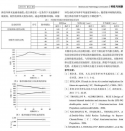@siegecrossbow
Could you post the original source? I wonder what the launch altitude and speed is?
Could you post the original source? I wonder what the launch altitude and speed is?
My guess would be that the missile alters the pulse duration based on data feed back from the fire control radar.
@siegecrossbow
Could you post the original source? I wonder what the launch altitude and speed is?
Altering duration of a solid-fuel rocket engine?My guess would be that the missile alters the pulse duration based on data feed back from the fire control radar.
Altering duration of a solid-fuel rocket engine?
View attachment 78904
Here is an interesting document that my answer why PL-15E has a max range of 145KM as opposed to PL-15's speculated range of around 180KM. The table lists the maximum range of AAM depending on the duration of time that elapses between the two pulses of a dual-pulse rocket motor. Under the head-on condition, the maximum range occurs when there is a 30 second gap between firing. If the gap between firing is 0s, the head-on maximum range is -- SURPRISE -- 145KM. What do you call a dual-pulse rocket motor with no pause between firing? A plain old single-pulse rocket motor.
This pretty much confirmed my suspicion that PL-15E does not feature dual-pulse rocket motor.
Wow nice find. This stuff isn't classified at all?
So the essential max difference for applying dual pulse on the PL-15 specifically seems to be roughly 35km extra range with same probability of intercept. This 35km extra range for basically controlling second boost timing is assumed to be at optimal factors under which second boost is to be performed i.e. the max extension having dual pulse over non dual pulse is a MAX of 35km extra or roughly 25% more effective range to achieve same P(K)... obviously I mean what else is it measuring against.
I assumed it would be a little less effective range but more probability of kill within that stretch where the missile is losing KE at the extremes of range. 25% range boost might translate from higher P(K) at extremes of undetermined (unspecified) range.
The original article was purely academic and didn't mention the missile type, why would it be classified?
What I found interesting is that the optimal pulse duration differs depending on the head-on/tail-on condition. For head-on condition, a 30 second gap can achieve the best result of 187KM. Tail-on, however, you need to wait 50 seconds between pulses to achieve 30KM range.
Very interesting! Do you have a better quality scan? As a lot of the words and numbers are hard to make out in this one.
On the bolded part, I would have to disagree because even a dual pulse rocket with zero time delay between pulses is going to be significantly superior to a single pulse rocket of the same size.
The biggest limitation with solid fuel rockets is that they cannot be throttled, so it’s one speed the whole way.
The obvious problem with this is that beyond the maximum design speed of the missile, all that additional thrust is just wasted on exponentially increasing drag.
A dual pulse rocket solves this issue by allowing you to configure the two rockets to burn at different rates. Rapid for the first stage for maximum acceleration, and slower for the second to maximum range and burn time.
The domestic PL15 with 30s delay between burns should have superior terminal performance and KP at extended ranges because it is adding 30s of powered flight to the end of its flight envelope, where it matters the most
Makes sense. When between burn pulses, the missile is flying on pure inertia, but through very thin air so it will be loosing speed fairly slowly. The longer the time between burns, the more ‘free’ range it gets.
Carrying on from the point earlier, when a rocket motor is ignited, it is most efficient at the start when it is accelerating the missile to its designed top speed. Once you reach that speed, you start to hit a brick wall in terms of additional velocity due to the massively increased air resistance. But since solid fuel rocket motors cannot be throttled back, it is just in effect wasting almost all of its burn pushing against that air resistance and not adding much in the way of range.
With a head-on engagement, the missile is launched at the target when the distance from the launch platform is 180km, but because it is head on, the distance the missile needs to fly is a lot less.
With a chase shot, you will be firing the missile a lot closer to the enemy plane, but the total distance covered by the missile will be 180km by the time it catches up to the fleeing enemy.

@siegecrossbow
Could you post the original source? I wonder what the launch altitude and speed is?
条件1。发射高度 10 km,
速度 Ma1.2;目标高度 10 km,速度 Ma0.9;进入角 180°, 目标不机动。
It seems second set of data is also in a heading-on scenario just lower altitude and speed. It's some what surprising to me that denser air at 3km would decrease missile range by almost tenfold compare to at 10km.Apologies. I found more information on the article and I was off by a little with my guess.
The launch vehicle is traveling at a speed of Ma 1.2, not Ma 0.9. All other specs I guessed correctly.
Going out of thick air to launch and then back, switching between going offensive/defensive, and so on is absolute core of modern BVR tactics.It's some what surprising to me that denser air at 3km would decrease missile range by almost tenfold compare to at 10km.
